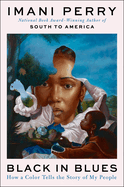
In Black in Blues: How a Color Tells the Story of My People, Imani Perry (South to America) offers haunting reflections on the strong connections between the color blue and the history of Black people. In a lyrical style, she muses about the roles that blue has played: blue, the feeling of sadness; blue, the sound of thoughtful music; blue, the color of beads that enslavers traded for Black lives in the Congo.
As Perry writes, "The association of the color blue with sadness is of English origin. The sound is African-rooted. The color is global." She expertly uses this framework to tell the stories of many Black people, including Liberian settlers, members of the Nation, and Toni Morrison. Perry finds insight in work by people she'd long known about: Rosa Parks and Duke Ellington and W.E.B. Du Bois. This led to discoveries of figures she was less familiar with, such as Jean-Jacques Dessalines, the Haitian revolutionary; Paul Gonsalves, the Cape Verdean American jazz musician; and Andrée Blouin, an extreme rarity: a Black female political activist and anticolonialist leader from the Central African Republic.
Perry's spare and poetic writing powerfully encapsulates history. It also underlines the frequency with which English-language speakers refer to ideas such as black-and-blue bruising, blue-black skin and hair, or the blues music predominantly played by Black musicians.
Black in Blues is sure to appeal to readers who enjoy exploring social justice topics. Perry's blue-tinted history offers a fascinating lens through which to see the world. --Jessica Howard, freelance book reviewer

